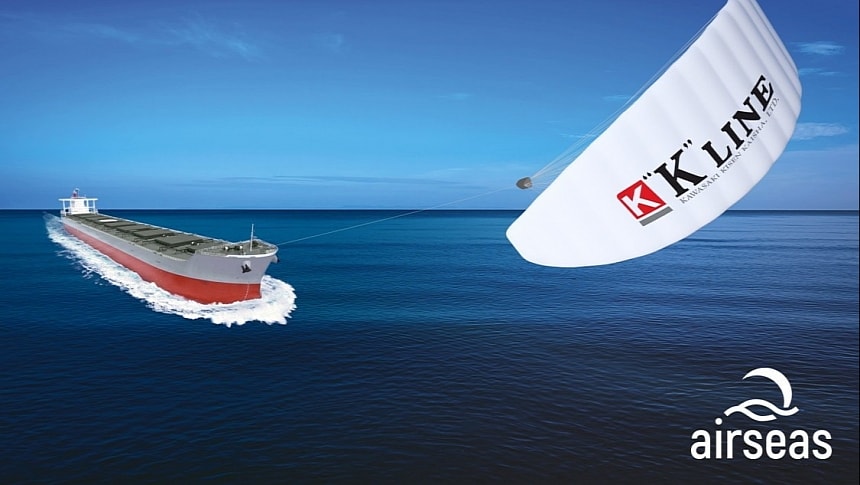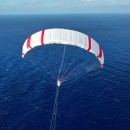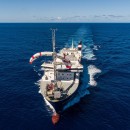The French maritime tech company Airseas was acquired by the Japanese shipping giant K Line (Kawasaki Kisen Kaisha) this month, allowing K Line to take full responsibility for developing and commercializing the innovative wind power propulsion system known as Seawing.
K-Line is now the official owner of the Seawing technology after it acquired Airseas and set up a France-based subsidiary, Oceanicwing. K Line and Airseas began their collaboration back in 2019 when the shipping company confirmed its intention to install the Seawing system on 51 of its ships. The French maritime company had been established just a few years prior and gained notoriety after securing financial support from Airbus.
It makes sense for the Japanese operator to bet on this groundbreaking propulsion solution on its path to decarbonizing all operations. K-Line doesn't just want to meet the most recent requirements established by IMO (International Maritime Organization) but also to surpass them by up to 40%. This will translate to improving its emission-related efficiency by half compared to 2008, and it's expected to happen before the end of the decade.
Seawing is one of the many cutting-edge sailing technologies that take a fresh approach to the ancient use of wind power. It was designed as an auxiliary propulsion system, meaning it would work hand in hand with the main propulsion based on either conventional fuel or alternative fuel (mainly LNG). Adding the Seawing system to a vessel could lower CO2 emissions by 20%, even more so if LNG is used instead of conventional fuel for the main propulsion.
Another thing that makes Seawing particularly intriguing is that it uses the simple concept of a kite in combination with cutting-edge automation technology. Unlike other modern-day sailing alternatives, such as rotor sails, this futuristic kite doesn't need power from the ship or any other kind of supply facility.
When the ship is on the move, an automated system launches the Seawing, which is basically a parafoil wing that's tethered to the bow of the ship. The onboard system then steers the wing automatically and continually monitors performance and safety data. The commercial version of Seawing is expected to boast a 1,000-square-meter (10,760 square feet) parafoil that can operate as high as 1,000 feet (304 meters).
Over the past couple of years, smaller versions of Seawing have been used for sea trials after successful onshore testing. At the beginning of last year, a Seawing kite was installed for the first time on one of K Line's Capesize bulkships (the largest class of bulkships that cannot pass through the Panama Canal).
From now on, K Line will be fully in charge of further developing the Seawing technology and bringing it to the market. As for Airbus and its shipping partner Louis Dreyfus Armateurs, they are now betting on a different kind of wind-based propulsion solution, the Norsepower rotor sails.
It makes sense for the Japanese operator to bet on this groundbreaking propulsion solution on its path to decarbonizing all operations. K-Line doesn't just want to meet the most recent requirements established by IMO (International Maritime Organization) but also to surpass them by up to 40%. This will translate to improving its emission-related efficiency by half compared to 2008, and it's expected to happen before the end of the decade.
Seawing is one of the many cutting-edge sailing technologies that take a fresh approach to the ancient use of wind power. It was designed as an auxiliary propulsion system, meaning it would work hand in hand with the main propulsion based on either conventional fuel or alternative fuel (mainly LNG). Adding the Seawing system to a vessel could lower CO2 emissions by 20%, even more so if LNG is used instead of conventional fuel for the main propulsion.
Another thing that makes Seawing particularly intriguing is that it uses the simple concept of a kite in combination with cutting-edge automation technology. Unlike other modern-day sailing alternatives, such as rotor sails, this futuristic kite doesn't need power from the ship or any other kind of supply facility.
When the ship is on the move, an automated system launches the Seawing, which is basically a parafoil wing that's tethered to the bow of the ship. The onboard system then steers the wing automatically and continually monitors performance and safety data. The commercial version of Seawing is expected to boast a 1,000-square-meter (10,760 square feet) parafoil that can operate as high as 1,000 feet (304 meters).
Over the past couple of years, smaller versions of Seawing have been used for sea trials after successful onshore testing. At the beginning of last year, a Seawing kite was installed for the first time on one of K Line's Capesize bulkships (the largest class of bulkships that cannot pass through the Panama Canal).
From now on, K Line will be fully in charge of further developing the Seawing technology and bringing it to the market. As for Airbus and its shipping partner Louis Dreyfus Armateurs, they are now betting on a different kind of wind-based propulsion solution, the Norsepower rotor sails.








